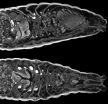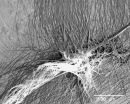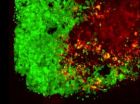(Press-News.org) To quote the American cartoonist Gary Larson: all things play a role in nature, even the lowly worm—but perhaps never in such a visually stunning way as that presented in two papers published today in the open access journals GigaScience and PLOS ONE. The work and data presented here provide the first-ever comparative study of earthworm morphology and anatomy using a 3D non-invasive imaging technique called micro-computed tomography (or microCT), which digitizes worm structures. This opens the possibility of scanning millions of specimens from museum collections, including extinct species, all of which is important given that the earthworm is both a benefit and a bane to ecosystems.
From digging in the garden to fishing to playing with worm farms at school, everyone has become aware of the importance of earthworms in maintaining ecosystems and soil quality, but few realize that many earthworm species are invasive and can be a serious threat to their new environment. More difficult yet is distinguishing one worm from another, and with thousands of known species around the globe, differentiating them and resolving their taxonomy is an enormous task. The difficulties in dissecting small, soft-bodied organisms, as well as having access to valuable and rare museum specimens, can make doing so nearly insurmountable. However, the research published today by Dr. Rosa Fernández and her colleagues from Harvard University as well as Dr. Alexander Ziegler from Ziegler Biosolutions provides the much-needed tools to carry out such analyses in a non-destructive way and at a significantly quicker pace. Their work combines two- and three-dimensional imaging techniques and shows that commonly used morphological features for defining earthworm taxonomy can now be assessed without the need for dissection. The researchers were able to view the sediment inside the animal in 3D, as well as the internal organs in context with each other. They also compared fresh samples with preserved museum specimens, going as far back as 1945, and revealed that this digital imaging technique is suitable for the analysis of rare museum specimens.
On top of releasing beautiful high-resolution videos allowing non-destructive 3D real-time dissection of earthworms, the authors made supporting raw and derived data available in a fully open access format through GigaScience's repository, GigaDB, enabling future data mining by researchers, the development of new tools, as well as provision of increased transparency and confidence in the research. Lead and corresponding authors on the papers, Dr. Rosa Fernández and Dr. Alexander Ziegler say that they would be delighted if their study "will serve as a catalyst for future high-throughput studies of zoological specimens and will also boost enforced data deposition practices in biodiversity research", opening new possibilities for computer-based interactive exploration and study of museum specimens around the world.
Making the data openly available is especially unique because, although open access to supporting data is the norm in some areas of research, for the morphology and taxonomy community this is much less common and, in practice, more difficult. Such issues have led to community concerns that data deposition policies adopted by journals such GigaScience and PLOS ONE may not be able to deal with large and complex datasets, such as these large stacks of imaging files. Thus, the data release effort by the authors and by GigaScience and PLOS ONE working together constitutes a major step forward in data transparency, making use of the online database MCZbase and the big data capabilities of GigaDB. Despite some of the folders being close to 10 GB in size, the data reviewers were able to retrieve each of those in as little as half an hour using GigaDB's high-speed Aspera internet connection.
Dr. Sarah Faulwetter of the Hellenic Centre for Marine Research, who served as a reviewer, felt that the level of data availability brings taxonomy into a new age, saying, "Instead of having to go through the lengthy process of obtaining the physical specimen from a museum, I can now download a fairly accurate representation from the web."
As the British natural scientist Charles Darwin said of the humble earthworm in the late 1800s, "It may be doubted whether there are many other animals which have played so important a part in the history of the world, as have these lowly organized creatures", but, today, how they are organized has never been seen so clearly or been so easily viewed.
INFORMATION:
Further Reading
1. Lenihan, J; Kvist, S; Fernández, R; Giribet, G; Ziegler, A (2014) A dataset comprising four micro-computed tomography scans of freshly fixed and museum earthworm specimens. GigaScience, 3:6 http://dx.doi.org/10.1186/2047-217X-3-6
2. Lenihan, J; Kvist, S; Fernández, R; Giribet, G; Ziegler, A (2014): MicroCT scans of freshly fixed and museum earthworm specimens. GigaScience Database. http://dx.doi.org/10.5524/100092
3. Fernández, R; Kvist, S; Lenihan J, Giribet G, Ziegler A (2014) Sine systemate chaos? A versatile tool for earthworm taxonomy: non-destructive imaging of freshly fixed and museum specimens using micro-computed tomography PLOS ONE 9 (5) e96617 doi:10.1371/journal.pone.0096617
Journal Information
1. GigaScience is co-published by BGI, the world's largest genomics organization, and BioMed Central, the world's first open-access publisher. The journal covers research that uses or produces 'big data' from the full spectrum of the life sciences. It also serves as a forum for discussing the difficulties of and unique needs for handling large-scale data from all areas of the life sciences. The journal has a completely novel publication format — one that integrates manuscript publication with complete data hosting, and analyses tool incorporation. To encourage transparent reporting of scientific research as well as enable future access and analyses, it is a requirement of manuscript submission to GigaScience that all supporting data and source code be made available in the GigaScience database, GigaDB, as well as in their publicly available repositories. GigaScience will provide users access to associated online tools and workflows, maximizing the potential utility and re-use of data. (Follow us on twitter @GigaScience; Facebook, and keep up-to-date on our blog).
2. BioMed Central is an STM (Science, Technology and Medicine) publisher, which pioneered the open-access publishing model. All peer-reviewed research articles published by BioMed Central are made immediately and freely accessible online, and are licensed to allow redistribution and reuse. BioMed Central is part of Springer Science+Business Media, a leading global publisher in the STM sector.
The early earthworm catches on to full data release
New research and data published today from GigaScience and PLOS ONE provide complete open access to detailed 3-D images of earthworms
2014-05-17
ELSE PRESS RELEASES FROM THIS DATE:
JCI online ahead of print table of contents for May 16, 2014
2014-05-16
Targeting microbial translocation attenuates SIV-mediated inflammation
Patients with HIV often present with signs of immune activation and systemic inflammation, both of which are hypothesized to directly contribute to the development of AIDs in infected individuals. HIV and the related simian immunodeficiency virus (SIV) damage the gut mucosa, leading to translocation of microbes from the intestinal lumen to the general circulation, but it is not clear if microbial translocation is directly responsible for chronic HIV-associated inflammation. In this issue of the Journal ...
Methadone programs can be key in educating, treating HCV patients
2014-05-16
BUFFALO, N.Y. – People who inject drugs and are enrolled in a drug treatment program are receptive to education about, and treatment for, hepatitis C virus, according to a study by researchers at several institutions, including the University at Buffalo.
That finding, published online this week in the Journal of Addiction Medicine will be welcome news to health care providers. The paper notes that injection drug use is a primary mode of infection, making for an HCV infection prevalence as high as 80 percent among people who inject drugs.
"One of the most important findings ...
Non-invasive lithotripsy leads to more treatment for kidney stones
2014-05-16
DURHAM, N.C. – When it comes to treating kidney stones, less invasive may not always be better, according to new research from Duke Medicine.
In a direct comparison of shock wave lithotripsy vs. ureteroscopy – the two predominant methods of removing kidney stones – researchers found that ureteroscopy resulted in fewer repeat treatments.
The findings were published May 16, 2014, in the journal JAMA Surgery, coinciding with presentation at the annual meeting of the American Urological Association.
"Nearly one out of 11 people in the United States has kidney stones, ...
Cognitive behavioral or relaxation training helps women reduce distress during breast cancer treatment
2014-05-16
Coral Gables, Fla. (May 16, 2014) – Can psychological intervention help women adapt to the stresses of breast cancer? It appears that a brief, five-week psychological intervention can have beneficial effects for women who are dealing with the stresses of breast cancer diagnosis and surgery. Intervening during this early period after surgery may reduce women's distress and providing cognitive or relaxation skills for stress management to help them adapt to treatment.
Researchers at the University of Miami recruited 183 breast cancer patients from surgical oncology clinics ...
Spiders spin possible solution to 'sticky' problems
2014-05-16
Researchers at The University of Akron are again spinning inspiration from spider silk—this time to create more efficient and stronger commercial and biomedical adhesives that could, for example, potentially attach tendons to bones or bind fractures.
The Akron scientists created synthetic duplicates of the super-sticky, silk "attachment discs" that spiders use to attach their webs to surfaces. These discs are created when spiders pin down an underlying thread of silk with additional threads, like stiches or staples, explains Ali Dhinojwala, UA's H. A. Morton professor ...
With imprecise chips to the artificial brain
2014-05-16
This news release is available in German. Which circuits and chips are suitable for building artificial brains using the least possible amount of power? This is the question that Junior Professor Dr. Elisabetta Chicca from the Center of Excellence Cognitive Interaction Technology (CITEC) has been investigating in collaboration with colleagues from Italy and Switzerland.
Their surprising finding: Constructions that use not only digital but also analog compact and imprecise circuits are more suitable for building artificial nervous systems, rather than arrangements ...
Lighting the way to graphene-based devices
2014-05-16
Graphene continues to reign as the next potential superstar material for the electronics industry, a slimmer, stronger and much faster electron conductor than silicon. With no natural energy band-gap, however, graphene's superfast conductance can't be switched off, a serious drawback for transistors and other electronic devices. Various techniques have been deployed to overcome this problem with one of the most promising being the integration of ultrathin layers of graphene and boron nitride into two-dimensional heterostructures. As conductors, these bilayered hybrids ...
Herpes-loaded stem cells used to kill brain tumors
2014-05-16
Harvard Stem Cell Institute (HSCI) scientists at Massachusetts General Hospital have a potential solution for how to more effectively kill tumor cells using cancer-killing viruses. The investigators report that trapping virus-loaded stem cells in a gel and applying them to tumors significantly improved survival in mice with glioblastoma multiforme, the most common brain tumor in human adults and also the most difficult to treat.
The work, led by Khalid Shah, MS, PhD, an HSCI Principal Faculty member, is published in the Journal of the National Cancer Institute. Shah heads ...
Ataluren Phase 3 trial results in nonsense mutation cystic fibrosis
2014-05-16
SOUTH PLAINFIELD, NJ – May 16, 2014 – PTC Therapeutics, Inc. (NASDAQ: PTCT) today announced that the results of a Phase 3 study of ataluren in patients with nonsense mutation cystic fibrosis (nmCF) were published in Lancet Respiratory Medicine. The results demonstrated positive trends in both the primary endpoint, lung function as measured by relative change in % predicted FEV1 (forced expiratory volume in one second) and in the secondary outcome measure, rate of pulmonary exacerbations. The collective data from this trial, including retrospective and subgroup analyses ...
Glasses-free 3-D projector
2014-05-16
Over the past three years, researchers in the Camera Culture group at the MIT Media Lab have steadily refined a design for a glasses-free, multiperspective, 3-D video screen, which they hope could provide a cheaper, more practical alternative to holographic video in the short term.
Now they've designed a projector that exploits the same technology, which they'll unveil at this year's Siggraph, the major conference in computer graphics. The projector can also improve the resolution and contrast of conventional video, which could make it an attractive transitional technology ...
LAST 30 PRESS RELEASES:
Sports injuries sustained during your period might be more severe
World's first successful 2 Tbit/s free-space optical communication using small optical terminals mountable on satellites and HAPS
Can intimate relationships affect your heart? New study says ‘yes’
Scalable and healable gradient textiles for multi‑scenario radiative cooling via bicomponent blow spinning
Research shows informed traders never let a good climate crisis go to waste
Intelligent XGBoost framework enhances asphalt pavement skid resistance assessment
Dual-function biomaterials for postoperative osteosarcoma: Tumor suppression and bone regeneration
New framework reveals where transport emissions concentrate in Singapore
NTP-enhanced lattice oxygen activation in Ce-Co catalysts for low-temperature soot combustion
Synergistic interface engineering in Cu-Zn-Ce catalysts for efficient CO2 hydrogenation to methanol
COVID-19 leaves a lasting mark on the human brain
Scientists use ultrasound to soften and treat cancer tumors without damaging healthy tissue
Community swimming program for Black youth boosts skills, sense of belonging, study finds
Specific depressive symptoms in midlife linked to increased dementia risk
An ‘illuminating’ design sheds light on cholesterol
Who is more likely to get long COVID?
Study showcases resilience and rapid growth of “living rocks”
Naval Research Lab diver earns Office of Naval Research 2025 Sailor of the Year
New Mayo-led study establishes practical definition for rapidly progressive dementia
Fossil fuel industry’s “climate false solutions” reinforce its power and aggravate environmental injustice
Researchers reveal bias in a widely used measure of algorithm performance
Alcohol causes cancer. A study from IOCB Prague confirms damage to DNA and shows how cells defend against it
Hidden viruses in wastewater treatment may shape public health risks, study finds
Unlock the power of nature: how biomass can transform climate mitigation
Biochar reshapes hidden soil microbes that capture carbon dioxide in farmland
Reducing saturated fat intake shows mortality benefit, but only in high-risk individuals
Manta rays create mobile ecosystems, study finds
Study: Mixed results in using lipoic acid to treat progressive multiple sclerosis
Norbert Holtkamp appointed director of Fermi National Accelerator Laboratory
New agentic AI platform accelerates advanced optics design
[Press-News.org] The early earthworm catches on to full data releaseNew research and data published today from GigaScience and PLOS ONE provide complete open access to detailed 3-D images of earthworms





